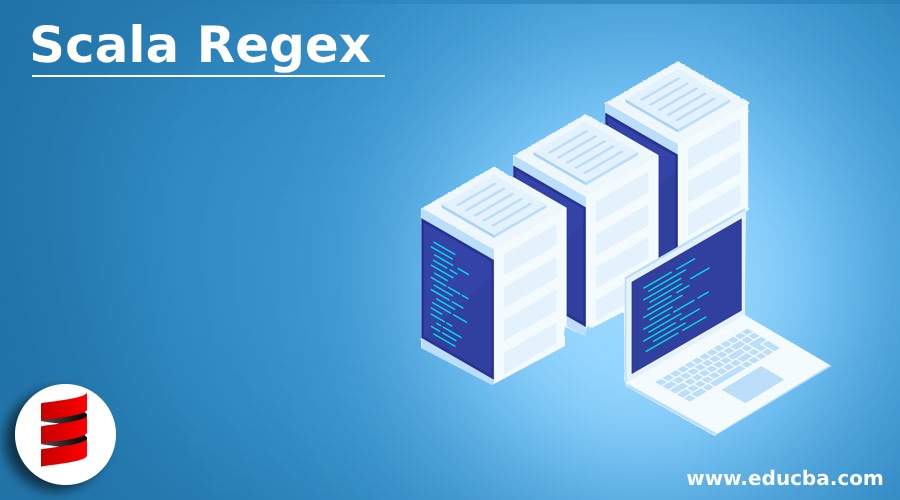Updated April 12, 2023

Introduction to Scala Regex
This is a guide to Scala Regex. Regex stands for regular expression. We can define some pattern using regular expression and we can use this regular expression to test our input parameter passed. Regular expression is used in so many different programming languages. In scala they work in the same way like Java. We write our regular expression in some pattern or it is a sequence of character to check our string or integer passed is valid or not.
How Regex work in Scala?
In scala regular expression works in the same way like they work in other languages. In scala we can find this class inside scala.util.matchingpackage named Regex. So this is the full path of the package >>scala.util.matching.Regex. We use this Regex class to search substring within a string or for parsing as well. We can follow to approach to deal with regular expression. We can direct assign our regular expression to string then convert it to regex object but calling some method. Also we can do one more thing like we can pass our pattern to regex object only.
1. Convert string to regex object
To convert our string to regex object we can call r() method of scala to again recast it to regex object.
Syntax:
valstr = "Here is some string".rIn this above code what is happening like we are casting our string to regex object by calling r() method on it.
2. Direct assign to regex object
In this approach we can directly assign our string to regex object only without need of calling the r() method explicitly.
Syntax:
valreg = new Regex("(A|b)fh")In the above syntax we are passing our pattern directly to regex object only.
Scala Regex Functions
We have so many different functions available in scala regex class to handle our string or input passed.
Given below is the list of various functions with example:
1. findAllIn(source: CharSequence)
This will find the substring into the source string.
Example:
Code:
import scala.util.matching.Regex
object Main extends App{
// Your code here!
valstr = "Hello to all".r
val source = "Hello to all from world"
println(strfindFirstIn source)
}Output:
2. findAllMatchIn(source: CharSequence)
Find all non-overlapping. Print those string as output.
Example:
Code:
import scala.util.matching.Regex
object Main extends App{
// Your code here!
valstr = "Hello to all to test regularexpression".r
val source = "Hello to all from world"
println(strfindAllMatchIn source)
}Output:
3. findFirstIn(source: CharSequence)
This method will find the first occurrence of string from source and print it.
Example:
Code:
import scala.util.matching.Regex
object Main extends App{
// Your code here
valstr = "to".r
val source = "Hello to all from world"
println(strfindFirstIn source)
}Output:
4. replaceAllIn()
It will replace the string with specified input.
Example:
Code:
import scala.util.matching.Regex
object Main extends App{
// Your code here!
valstr = "replacetest"
valfinalstr = "replacetest".replaceAll(".test", "**")
println("befor ::" + str)
println("aftre ::" + finalstr)
}Output:
5. replaceFirst()
replace first occurrence.
Example:
Code:
import scala.util.matching.Regex
object Main extends App{
// Your code here!
valstr = "replacetest"
valfinalstr = "replacetest".replaceFirst(".test", "**")
println("befor ::" + str)
println("aftre ::" + finalstr)
}Output:
6. matches()
This method is going to match the string with pattern we pass and it will return true or false based on the result or if it got the string matches with the pattern.
Example:
Code:
import scala.util.matching.Regex
object Main extends App{
// Your code here!
varstr = "check"
valfinalstr = str.matches(".*k")
// Displays output
println(finalstr)
}Output:
7. split(String regex, int limit)
It will give us the array in return, but we can limit the number of objects in the array while returning.
Example:
Code:
import scala.util.matching.Regex
object Main extends App{
// Your code here!
varstr = "somestring to test the result"
valfinalstr = str.split(".ng", 4)
for ( s1 <-finalstr )
{
// Displays output
println( "Here the array ::"+s1)
}
}Output:
Examples of Scala Regex
Given below are the examples mentioned:
Example #1
\\d: It matched digit in any input passed [0-9]. This method checks for digit in an input.
Code:
import scala.util.matching.Regex
object Main extends App{
// Your code here!
valreg = new Regex("\\d")
valstr = "to check digit 520 in string"
println((regfindAllInstr).mkString(", "))
}Output:
Example #2
\\D: This method checks in the input passes whether it contains the non-digit.
Code:
import scala.util.matching.Regex
object Main extends App{
// Your code here!
valreg = new Regex("\\D")
valstr = "to check string 520 in string"
println((regfindAllInstr).mkString(", "))
}Output:
Example #3
\\S: Check the non-white space.
Code:
import scala.util.matching.Regex
object Main extends App{
// Your code here!
valreg = new Regex("\\S")
valstr = "to check string 520 in string"
println((regfindAllInstr).mkString(", "))
}Output:
Example #4
\\s: This method basically checks for white space present in the string and print them. [\t\n\r\f]
Code:
import scala.util.matching.Regex
object Main extends App{
// Your code here!
valreg = new Regex("\\s")
valstr = "to check string 520 in string"
println((regfindAllInstr).mkString(", "))
}Output:
Example #5
q|r: This expression check whether the string contains the q or r not and print them.
Code:
import scala.util.matching.Regex
object Main extends App{
// Your code here!
valreg = new Regex("q|r")
valstr = "Check regular expression"
println((regfindAllInstr).mkString(", "))
}Output:
Example #6
.: This method is used to check the new line. “.” Check in the string or input parameter if contain any new line.
Code:
import scala.util.matching.Regex
object Main extends App{
// Your code here!
valreg = new Regex(".")
valstr = "check for new line "
// printing them out.
println((regfindAllInstr).mkString(", "))
}Output:
Conclusion
So Scala Regex is similar to any other regular expression. It is basically used for searching and parsing in our input parameters that we passed for validation purpose. We can create different type of pattern and validate our input against them. Regular expression provides us many unbuild expression as well.
Recommended Articles
We hope that this EDUCBA information on “Scala Regex” was beneficial to you. You can view EDUCBA’s recommended articles for more information.






